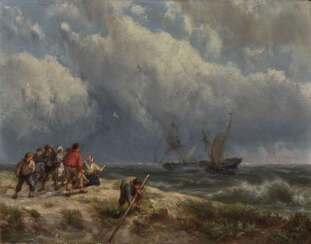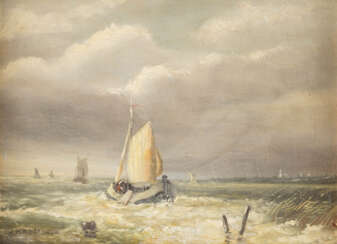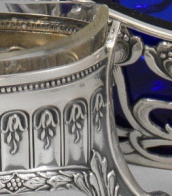oek 16

Hermanus Koekkoek was a distinguished Dutch painter known for his marine art. As a member of the renowned Koekkoek Painting Family, Hermanus followed in the footsteps of his father, Johannes Hermanus Koekkoek, and his brothers, becoming an influential figure in the realm of maritime and landscape painting.
His art education began under the tutelage of his father and later extended to formal studies at the Rijksakademie in Amsterdam, where he honed his skills in marine art, a genre that he primarily focused on throughout his career. Hermanus's works exhibit a blend of Realism and Romanticism, drawing inspiration from the Dutch Golden Age of painting. His contributions to the art world were recognized with a gold medal at an exhibition held by Arti et Amicitiae, an artists' society in Rotterdam.
Hermanus Koekkoek's paintings often depict serene maritime scenes, showcasing his adeptness at capturing the tranquility and dynamism of the sea. His works were well received not only in the Netherlands but also in Germany and England, and today, they can be viewed in prestigious institutions like the Teylers Museum and the Museum Boijmans Van Beuningen.
For art collectors and enthusiasts, Hermanus Koekkoek's oeuvre provides a captivating glimpse into 19th-century Dutch marine and landscape painting, offering a testament to his skill and artistry in capturing the essence of the natural world and maritime life.
If you are intrigued by Hermanus Koekkoek's artistry and wish to stay informed about exhibitions, sales, or auctions featuring his works, consider subscribing to updates related to this esteemed painter.


Johannes Hermanus Barend Koekkoek was a Dutch marine artist. He signed his paintings, and is perhaps better-known as, Jan H. B. Koekkoek.




Bernard van Orley was a versatile Flemish artist and representative of Dutch and Flemish Renaissance painting, who was equally active as a designer of tapestries and, at the end of his life, stained glass. Although he never visited Italy, he belongs to the group of Italianizing Flemish painters called the Romanists, who were influenced by Italian Renaissance painting, in his case especially by Raphael.


Hendrick Jansz ter Brugghen was a Dutch painter of genre scenes and religious subjects. He was one of the Dutch followers of Caravaggio – the so-called Utrecht Caravaggisti. Along with Gerrit van Hondhorst and Dirck van Baburen, Ter Brugghen was one of the most important Dutch painters to have been influenced by Caravaggio.
Ter Brugghen's favourite subjects were half-length figures of drinkers or musicians, but he also produced larger-scale religious images and group portraits. He carried with him Caravaggio's influence, and his paintings have a strong dramatic use of light and shadow, as well as emotionally charged subjects. His treatment of religious subjects can be seen reflected in the work of Rembrandt, and elements of his style can also be found in the paintings of Frans Hals and Johannes Vermeer. Peter Paul Rubens described ter Brugghen's work as "...above that of all the other Utrecht artists".


Pieter Cornelis Mondriaan, later known as Piet Mondrian, was a Dutch painter and art theoretician, whose transformation from figurative art to an abstract modernist style revolutionized the visual arts landscape of the 20th century. Born on March 7, 1872, in Amersfoort, Netherlands, and passing away on February 1, 1944, in New York, Mondrian's journey in art began in a devoutly Calvinist home where both art and music were encouraged. His early works were influenced by his surroundings, featuring landscapes in an Impressionist manner, but it was his shift to Paris in 1911 that marked the beginning of his profound evolution towards abstraction.
Mondrian co-founded the De Stijl art movement, aiming to achieve a universal aesthetic through the simplification of visual elements to their essentials: straight lines, right angles, primary colors, and the use of black, white, and gray. This reductionist approach, termed Neoplasticism, was Mondrian's contribution to creating 'universal beauty'. His philosophy extended beyond the canvas, influencing architecture, design, and fashion, encapsulating the modernist ideal and becoming synonymous with Modernism itself.
Some of Mondrian's notable works, such as "Composition with Red, Blue, and Yellow" and "Broadway Boogie Woogie", exemplify his revolutionary style, characterized by an economy of color and a rigorously abstract geometry that aimed to express the dynamic equilibrium of universal forces. These masterpieces, along with his theoretical writings, left a lasting impact on the course of abstract painting and several major art movements including Color Field painting, Abstract Expressionism, and Minimalism.
Mondrian's art is celebrated in museums and galleries worldwide, notably at the Gemeentemuseum Den Haag and the Museum of Modern Art in New York, where his evolution from figuration to geometric abstraction continues to inspire and captivate audiences. His commitment to exploring the spiritual in art through a radical simplification of form and color has cemented his legacy as one of the pioneers of 20th-century abstract art.
For collectors and experts in art and antiques, Mondrian's works represent not just significant artistic achievements but also pivotal moments in the history of modern art. His influence extends far beyond his own creations, shaping the development of modern aesthetics in numerous fields. If you're intrigued by Mondrian's vision of harmony and order through abstraction, we invite you to sign up for updates. This subscription will keep you informed about new product sales and auction events related to Mondrian's work, ensuring you stay connected to the ever-evolving world of art and design inspired by this iconic figure.


Gerard Dou was a Dutch Golden Age painter, whose small, highly polished paintings are typical of the Leiden fijnschilders. He specialised in genre scenes and is noted for his trompe-l'œil "niche" paintings and candlelit night-scenes with strong chiaroscuro. He was a student of Rembrandt.














































































